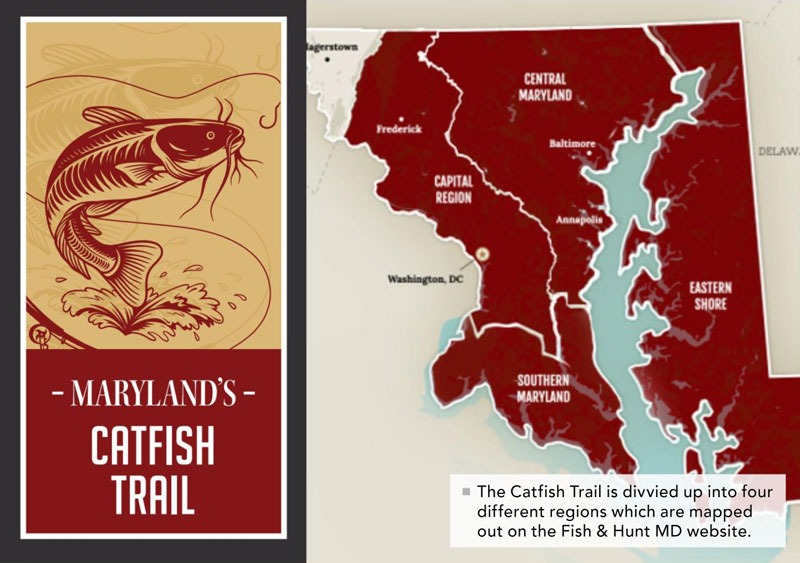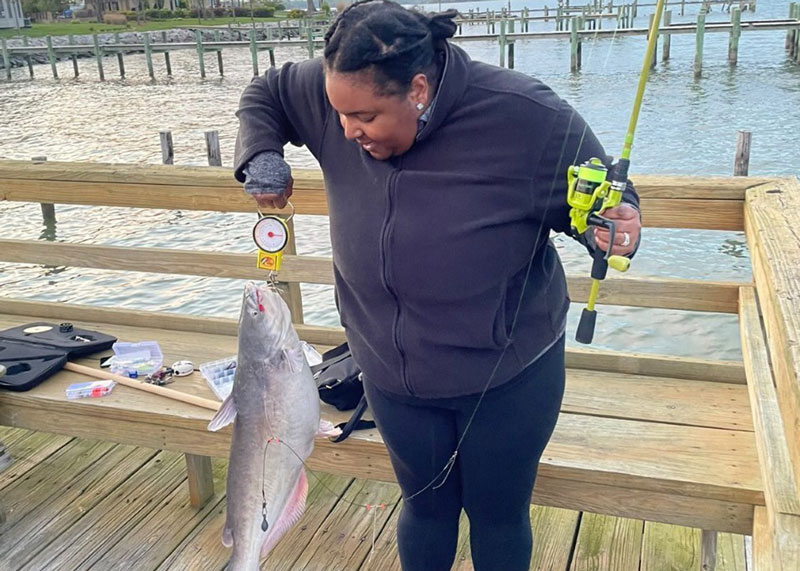
There’s no such thing as a sure thing in fishing, but in recent years targeting blue catfish has become about as close as it gets in many Maryland waterways. Channel cats have been around for decades and flatheads have expanded their presence, but it’s the invasive blue catfish that has undergone a serious population explosion since escaping from the confines of the middle Western Shore rivers and spreading to virtually every tributary on both sides of the Bay.

Why Catch a Catfish?
These fish aren’t just numerous, they can get big. As in, huge. In fact, the Maryland state record sits at 84 pounds — mustering more mass than the state’s Chesapeake Bay records for striped bass (67 pounds), red drum (74.4 pounds), and every other species tracked by the state except for cobia (97.8 pounds) and black drum (103.5 pounds). Considering that a 102-pounder has been recorded in the James River, there’s a possibility that someday a blue catfish could claim the mantle as the biggest fish in the Bay. But there’s a problem with these colossal catfish: they eat a lot. An awful lot. And since they didn’t previously exist in this ecosystem, chowing down on native species can have a serious impact. In fact, the Maryland DNR specifically wants we anglers to target these fish and remove those that we catch from an environment being thrown out of balance.
Added Bonus: blue catfish just so happen to be quite tasty. Unlike some other catfish species they have a firm white meat that’s quite mild. There’s no limit on their harvest so you can keep as many as you’d like, and the best size for eating, in the 20” to 30” range, also tend to be the most numerous. (Health advisories may be in effect for larger fish in some bodies of water; see the Maryland Department of the Environment).
Added Double-Bonus: these fish aren’t just numerous and good to eat, they’re also willing to bite 12 months out of the year. The action can be slowed at times by strong fronts and pressure changes (explaining why it doesn’t quite earn sure-thing status), but the vast majority of the time blue catfish will be on the feed.
Unheard-of Added TRIPLE Bonus: plenty of blue catfish hotspots are easily accessible from shore. No matter where you live in Maryland, if you’re near the I-95 corridor or to its east you’re mere minutes from an accessible shoreline fishing spot with great blue cat action. With so many different options close at hand, how will you know where to fish? Simple: just follow the Maryland Catfish Trail.

Hitting the Catfish Trail
The new Catfish Trail focuses on waters rich with blue catfish which have easily accessible public locations where you can walk down to the banks of a tributary river or the Bay, cast out, and have an excellent shot at reeling back one catfish after another. There are four regions: Eastern Maryland, Capital Region, Southern Maryland, and Central Maryland. You can find them mapped out at Fish & Hunt Maryland.
Click on the region of interest, and you’ll get a synopsis of the different locations available there. Check out the Central Region, for example, and you’ll learn about North Point State Park, the fishing piers at Havre De Grace, and more. Click on the Eastern Region to learn about Pocomoke River State Park, Cambridge Municipal Yacht Basin, and other options. Try the Southern Region and take a peek at Mattawoman Natural Environmental Area, Newtowne Neck State Park, and so on. Or visit the Capital Region to get the lowdown on hotspots for Potomac River catfish spots. Dozens of locations along the trail are detailed, and along with the info you’ll find on the Trail webpages there are also links going to each of the parks with websites where you can find out even more details about the location.
Catfishing ABCs
For a deep dive into catfishing tactics try a search for catfish here, but know that this is a fairly simple fishery. You’ll need a rod and reel that can handle 12- to 20-pound test or heavier, but just about any sort of rod action and type will work just fine. Either mono or braid line gets the job done, too. Slide a fishfinder-style rig or an egg sinker onto the mainline, then tie on a swivel. Next rig up three to four feet of 30- or 40-pound test monofilament leader with an 8/0 to 10/0 circle hook on the end, and if you’re using a fishfinder rig, clip on enough weight to hold bottom.
You can use any sort of cut fish for bait, though most people like bunker the best. Raw chicken breast, chicken liver, or small live fish like bluegill or pumpkinseed can be used as well. Cast out and let it sit until you get a bite. When the rod starts bending remember that with a circle hook you don’t want to jerk back to set the hook, but instead, slowly apply tension by reeling until the fish is on the line.

Family Time
Many of the hotspots called out in each of the four regions of the Catfish Trail are ideal places for taking the entire family on an angling outing. Since the action is likely to be fast the kids will love it, these are shoreline access spots open to the public, and many have additional facilities like restrooms, hiking trails, or picnic shelters. Several are even located in License Free fishing zones where beginners can try their hand at fishing without even buying a license.
Competitive Catfishing
There are several catfish tournaments you can get in on during the month of April. On the 13th there are two, the Sharptown Catfish Tournament at Cherry Beach Park (see the Sharptown Catfish Tournament on Facebook), and the Benedict VFD Catfish Tournament. Then on April 20 check out the Wicomico Environment Invasive Fishing Derby.
The Great Chesapeake Invasives Count
The CCA Maryland Great Chesapeake Invasives Count began this month, and this awesome effort lets you participate in citizen science and win a prize or two as you go fishing. Anyone can enter, and it’s completely free. Just register, then log your invasive catches including blue catfish, flathead catfish, and snakeheads, by taking a picture of them on a ruler. Every time you log a catch your name goes into a digital hat for the prize drawings. Open the fish’s stomach and photograph its contents (not required, but great intel for the science geeks), and your name goes into the hat a second time. At the end of every month winners are drawn for prizes like sunglasses, T-shirts, tumblers, and more.
The catch information and stomach contents information we anglers provide is shared with fishery managers to help them build an understanding of where these fish are concentrated, what they’re eating, and the overall state of our fisheries. So you not only get to go fishing and win stuff, you also help the scientifical types figure out how to handle the invasives invasion.
Okay: Are you ready to start trotting down the Catfish Trail? As soon as we heard about it we jumped in the car and set out for almost-sure-thing action — and 100-percent sure-thing fun!
One Catty Cover Contest
You say you’d love to see yourself, a friend, or your kid grace the cover of FishTalk Magazine? When you hit the Catfish Trail be sure to take plenty of pictures, because some lucky catfish hunter will end up being our November edition cover model. Pictures need to be:
- In a vertical upright format, with room at the top and bottom for the title and cover blurbs.
- High resolution and in focus.
- Showing a blue or flathead catfish caught in Maryland waters and an angler or anglers with BIG SMILES on their faces!
The contest will begin accepting entries in September, so stay tuned for more details and be sure to snap off some awesome cover-style photos as you enjoy catching those catfish all summer long — you never know, you might just end up on the cover of FishTalk!
See Blue Catfish in the Bullseye, Part II for 10 catfish fishing tips, and Blue Cats in the Bullseye Part III to learn how to target a mega-monster blue cat.